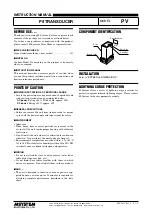
9
Frequency Agile UHF Belt-Pack Transmitter
Rio Rancho, NM – USA
Frequency Select Switch Locations
1.6M 100K
0 1
2
3
4
5
6
7
8
9
A
B
C
D
E
F
0 1
2
3
4
5
6
7
8
9
A
B
C
D
E
F
-10 LED
MIC input jack
AUDIO
LEVEL control
-20 LED
4)
Set the transmitter Power ON/OFF switch to ON.
5)
Position the microphone in the location where it will be used in actual operation.
6)
Observe the Modulation LEDS while speaking or singing at the same voice
level that will be used during the program. Gradually rotate the AUDIO
LEVEL control clockwise until the -20 LED glows red and the -10 dB glows
green with occasional red flickers. This indicates full modulation and is the
optimum setting for the transmitter’s gain.
7)
Once the LM’s audio gain has been set, the remaining components of the
audio system can be energized and adjusted.
OPERATING NOTES
DO NOT USE THE AUDIO LEVEL control for controlling the volume of your sound system or recorder levels. This
gain adjustment matches the transmitter gain with the user’s voice level and microphone positioning.
If the audio level is too high — the -20 LED will glow red and the -10 LED will frequently blink or glow
steady red. This condition may reduce the dynamic range of the audio signal.
If the audio level is too low — neither LED will light, or only the -20 LED will blink or glow green. This
condition may cause hiss and noise in the audio.
Different voices will usually require different settings of the AUDIO LEVEL control, so check this adjustment as each
new person uses the system. If several different people will be using the transmitter and there is not time to make
the adjustment for each individual, adjust it for the loudest voice.
ADJUSTING THE TRANSMITTER FREQUENCY
If you are experiencing interference from another signal on your operating frequency, you may need to change the
operating frequency of your system. This is done through two Frequency Select Switches located on the left side of
the transmitter case. (See Frequency Select Switch Locations.)
The left switch increments the operating frequency in 1.6 MHz steps. The right switch increments the operating
frequency in 100 kHz steps. It is suggested to use the metering on the associated receiver to find a clear channel.
Turn the transmitter off and leave the receiver turned on. Tune the receiver across its band and find a frequency
where little or no RF activity is displayed. Set the transmitter to this new frequency, then turn it on and make sure the
RF signal is strongly indicated at the receiver. Be sure the switch settings between the receiver and transmitter are
set exactly the same. If, for example, the 100K switch is one click above or below the desired frequency, the receiver
will indicate RF but no audio (or severely distorted audio) will be produced.
All 400 Series (and a number of earlier receivers) offer
a front panel LCDs that indicate the correct transmitter
switch settings when locating clear channels. Use the
scanning functions on these receivers to find a clear
channel, then switch both the receiver and transmitter
to the Frequency Select Switch settings indicated in
the receiver’s display.


































